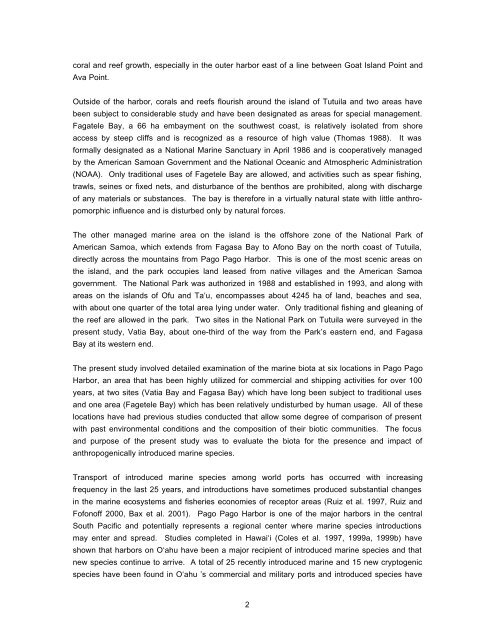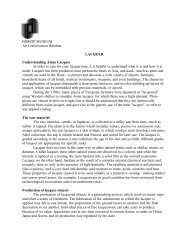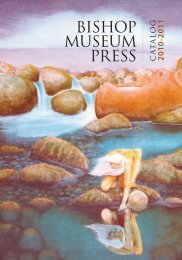INTRODUCED MARINE SPECIES IN PAGO ... - Bishop Museum
INTRODUCED MARINE SPECIES IN PAGO ... - Bishop Museum
INTRODUCED MARINE SPECIES IN PAGO ... - Bishop Museum
Create successful ePaper yourself
Turn your PDF publications into a flip-book with our unique Google optimized e-Paper software.
coral and reef growth, especially in the outer harbor east of a line between Goat Island Point and<br />
Ava Point.<br />
Outside of the harbor, corals and reefs flourish around the island of Tutuila and two areas have<br />
been subject to considerable study and have been designated as areas for special management.<br />
Fagatele Bay, a 66 ha embayment on the southwest coast, is relatively isolated from shore<br />
access by steep cliffs and is recognized as a resource of high value (Thomas 1988). It was<br />
formally designated as a National Marine Sanctuary in April 1986 and is cooperatively managed<br />
by the American Samoan Government and the National Oceanic and Atmospheric Administration<br />
(NOAA). Only traditional uses of Fagetele Bay are allowed, and activities such as spear fishing,<br />
trawls, seines or fixed nets, and disturbance of the benthos are prohibited, along with discharge<br />
of any materials or substances. The bay is therefore in a virtually natural state with little anthro-<br />
pomorphic influence and is disturbed only by natural forces.<br />
The other managed marine area on the island is the offshore zone of the National Park of<br />
American Samoa, which extends from Fagasa Bay to Afono Bay on the north coast of Tutuila,<br />
directly across the mountains from Pago Pago Harbor. This is one of the most scenic areas on<br />
the island, and the park occupies land leased from native villages and the American Samoa<br />
government. The National Park was authorized in 1988 and established in 1993, and along with<br />
areas on the islands of Ofu and Ta‘u, encompasses about 4245 ha of land, beaches and sea,<br />
with about one quarter of the total area lying under water. Only traditional fishing and gleaning of<br />
the reef are allowed in the park. Two sites in the National Park on Tutuila were surveyed in the<br />
present study, Vatia Bay, about one-third of the way from the Park’s eastern end, and Fagasa<br />
Bay at its western end.<br />
The present study involved detailed examination of the marine biota at six locations in Pago Pago<br />
Harbor, an area that has been highly utilized for commercial and shipping activities for over 100<br />
years, at two sites (Vatia Bay and Fagasa Bay) which have long been subject to traditional uses<br />
and one area (Fagetele Bay) which has been relatively undisturbed by human usage. All of these<br />
locations have had previous studies conducted that allow some degree of comparison of present<br />
with past environmental conditions and the composition of their biotic communities. The focus<br />
and purpose of the present study was to evaluate the biota for the presence and impact of<br />
anthropogenically introduced marine species.<br />
Transport of introduced marine species among world ports has occurred with increasing<br />
frequency in the last 25 years, and introductions have sometimes produced substantial changes<br />
in the marine ecosystems and fisheries economies of receptor areas (Ruiz et al. 1997, Ruiz and<br />
Fofonoff 2000, Bax et al. 2001). Pago Pago Harbor is one of the major harbors in the central<br />
South Pacific and potentially represents a regional center where marine species introductions<br />
may enter and spread. Studies completed in Hawai‘i (Coles et al. 1997, 1999a, 1999b) have<br />
shown that harbors on O‘ahu have been a major recipient of introduced marine species and that<br />
new species continue to arrive. A total of 25 recently introduced marine and 15 new cryptogenic<br />
species have been found in O‘ahu ’s commercial and military ports and introduced species have<br />
2






